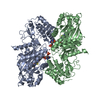+ Open data
Open data
- Basic information
Basic information
| Entry | Database: PDB / ID: 6k4n | |||||||||
|---|---|---|---|---|---|---|---|---|---|---|
| Title | Cryo-EM structure of p300 | |||||||||
 Components Components | Histone acetyltransferase p300 | |||||||||
 Keywords Keywords | TRANSCRIPTION / transcriptional coactivator / HAT / auto-inhibited closed conformation | |||||||||
| Function / homology |  Function and homology information Function and homology informationbehavioral defense response / peptidyl-lysine propionylation / histone lactyltransferase (CoA-dependent) activity / peptidyl-lysine crotonylation / peptidyl-lysine butyrylation / histone butyryltransferase activity / histone H3K122 acetyltransferase activity / swimming / peptide butyryltransferase activity / thigmotaxis ...behavioral defense response / peptidyl-lysine propionylation / histone lactyltransferase (CoA-dependent) activity / peptidyl-lysine crotonylation / peptidyl-lysine butyrylation / histone butyryltransferase activity / histone H3K122 acetyltransferase activity / swimming / peptide butyryltransferase activity / thigmotaxis / histone H2B acetyltransferase activity / peptide 2-hydroxyisobutyryltransferase activity / histone crotonyltransferase activity / protein propionyltransferase activity / NOTCH2 intracellular domain regulates transcription / peptidyl-lysine acetylation / lysine N-acetyltransferase activity, acting on acetyl phosphate as donor / histone H4 acetyltransferase activity / internal peptidyl-lysine acetylation / cellular response to L-leucine / histone H3 acetyltransferase activity / NFE2L2 regulating ER-stress associated genes / peptide N-acetyltransferase activity / acetylation-dependent protein binding / Activation of the TFAP2 (AP-2) family of transcription factors / NFE2L2 regulating inflammation associated genes / NGF-stimulated transcription / STAT3 nuclear events downstream of ALK signaling / histone H3K18 acetyltransferase activity / N-terminal peptidyl-lysine acetylation / histone H3K27 acetyltransferase activity / LRR FLII-interacting protein 1 (LRRFIP1) activates type I IFN production / NFE2L2 regulates pentose phosphate pathway genes / TGFBR3 expression / NFE2L2 regulating MDR associated enzymes / Polo-like kinase mediated events / regulation of androgen receptor signaling pathway / regulation of mitochondrion organization / positive regulation by host of viral transcription / Regulation of FOXO transcriptional activity by acetylation / face morphogenesis / Regulation of gene expression in late stage (branching morphogenesis) pancreatic bud precursor cells / regulation of glycolytic process / RUNX3 regulates NOTCH signaling / Regulation of gene expression by Hypoxia-inducible Factor / Nuclear events mediated by NFE2L2 / NOTCH4 Intracellular Domain Regulates Transcription / FOXO-mediated transcription of cell death genes / Regulation of NFE2L2 gene expression / NOTCH3 Intracellular Domain Regulates Transcription / platelet formation / TRAF6 mediated IRF7 activation / NFE2L2 regulating anti-oxidant/detoxification enzymes / peptide-lysine-N-acetyltransferase activity / megakaryocyte development / NFE2L2 regulating tumorigenic genes / macrophage derived foam cell differentiation / regulation of tubulin deacetylation / nuclear androgen receptor binding / STAT family protein binding / protein acetylation / acyltransferase activity / internal protein amino acid acetylation / fat cell differentiation / positive regulation of transforming growth factor beta receptor signaling pathway / Formation of paraxial mesoderm / stimulatory C-type lectin receptor signaling pathway / RUNX1 interacts with co-factors whose precise effect on RUNX1 targets is not known / PI5P Regulates TP53 Acetylation / acetyltransferase activity / Zygotic genome activation (ZGA) / RUNX3 regulates p14-ARF / NF-kappaB binding / histone acetyltransferase complex / Attenuation phase / intrinsic apoptotic signaling pathway in response to DNA damage by p53 class mediator / somitogenesis / negative regulation of protein-containing complex assembly / negative regulation of gluconeogenesis / cellular response to nutrient levels / canonical NF-kappaB signal transduction / positive regulation of T-helper 17 cell lineage commitment / pre-mRNA intronic binding / SARS-CoV-1 targets host intracellular signalling and regulatory pathways / histone acetyltransferase activity / regulation of cellular response to heat / histone acetyltransferase / skeletal muscle tissue development / NR1H3 & NR1H2 regulate gene expression linked to cholesterol transport and efflux / Regulation of TP53 Activity through Acetylation / Transferases; Acyltransferases; Transferring groups other than aminoacyl groups / RORA activates gene expression / positive regulation of TORC1 signaling / CD209 (DC-SIGN) signaling / B cell differentiation / negative regulation of autophagy / transcription initiation-coupled chromatin remodeling / TP53 Regulates Transcription of Genes Involved in G2 Cell Cycle Arrest / SUMOylation of transcription cofactors / regulation of signal transduction by p53 class mediator Similarity search - Function | |||||||||
| Biological species |  Homo sapiens (human) Homo sapiens (human) | |||||||||
| Method | ELECTRON MICROSCOPY / single particle reconstruction / cryo EM / Resolution: 9.8 Å | |||||||||
 Authors Authors | Ghosh, R. / Roy, S. / Sengupta, J. | |||||||||
 Citation Citation |  Journal: Biochemistry / Year: 2019 Journal: Biochemistry / Year: 2019Title: Tumor Suppressor p53-Mediated Structural Reorganization of the Transcriptional Coactivator p300. Authors: Raka Ghosh / Stephanie Kaypee / Manidip Shasmal / Tapas K Kundu / Siddhartha Roy / Jayati Sengupta /  Abstract: Transcriptional coactivator p300, a critical player in eukaryotic gene regulation, primarily functions as a histone acetyltransferase (HAT). It is also an important player in acetylation of a number ...Transcriptional coactivator p300, a critical player in eukaryotic gene regulation, primarily functions as a histone acetyltransferase (HAT). It is also an important player in acetylation of a number of nonhistone proteins, p53 being the most prominent one. Recruitment of p300 to p53 is pivotal in the regulation of p53-dependent genes. Emerging evidence suggests that p300 adopts an active conformation upon binding to the tetrameric p53, resulting in its enhanced acetylation activity. As a modular protein, p300 consists of multiple well-defined domains, where the structured domains are interlinked with unstructured linker regions. A crystal structure of the central domain of p300 encompassing Bromo, RING, PHD, and HAT domains demonstrates a compact module, where the HAT active site stays occluded by the RING domain. However, although p300 has a significant role in mediating the transcriptional activity of p53, only a few structural details on the complex of these two full-length proteins are available. Here, we present a cryo-electron microscopy (cryo-EM) study on the p300-p53 complex. The three-dimensional cryo-EM density map of the p300-p53 complex, when compared to the cryo-EM map of free p300, revealed that substantial change in the relative arrangement of Bromo and HAT domains occurs upon complex formation, which is likely required for exposing HAT active site and subsequent acetyltransferase activity. Our observation correlates well with previous studies showing that the presence of Bromodomain is obligatory for effective acetyltransferase activity of HAT. Thus, our result sheds new light on the mechanism whereby p300, following binding with p53, gets activated. | |||||||||
| History |
|
- Structure visualization
Structure visualization
| Movie |
 Movie viewer Movie viewer |
|---|---|
| Structure viewer | Molecule:  Molmil Molmil Jmol/JSmol Jmol/JSmol |
- Downloads & links
Downloads & links
- Download
Download
| PDBx/mmCIF format |  6k4n.cif.gz 6k4n.cif.gz | 35.8 KB | Display |  PDBx/mmCIF format PDBx/mmCIF format |
|---|---|---|---|---|
| PDB format |  pdb6k4n.ent.gz pdb6k4n.ent.gz | 16 KB | Display |  PDB format PDB format |
| PDBx/mmJSON format |  6k4n.json.gz 6k4n.json.gz | Tree view |  PDBx/mmJSON format PDBx/mmJSON format | |
| Others |  Other downloads Other downloads |
-Validation report
| Summary document |  6k4n_validation.pdf.gz 6k4n_validation.pdf.gz | 759.4 KB | Display |  wwPDB validaton report wwPDB validaton report |
|---|---|---|---|---|
| Full document |  6k4n_full_validation.pdf.gz 6k4n_full_validation.pdf.gz | 761.1 KB | Display | |
| Data in XML |  6k4n_validation.xml.gz 6k4n_validation.xml.gz | 14.6 KB | Display | |
| Data in CIF |  6k4n_validation.cif.gz 6k4n_validation.cif.gz | 20.4 KB | Display | |
| Arichive directory |  https://data.pdbj.org/pub/pdb/validation_reports/k4/6k4n https://data.pdbj.org/pub/pdb/validation_reports/k4/6k4n ftp://data.pdbj.org/pub/pdb/validation_reports/k4/6k4n ftp://data.pdbj.org/pub/pdb/validation_reports/k4/6k4n | HTTPS FTP |
-Related structure data
| Related structure data |  6792MC  6791C  5xzcC M: map data used to model this data C: citing same article ( |
|---|---|
| Similar structure data |
- Links
Links
- Assembly
Assembly
| Deposited unit | 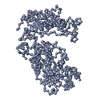
|
|---|---|
| 1 |
|
- Components
Components
| #1: Protein | Mass: 72100.062 Da / Num. of mol.: 1 / Fragment: UNP RESIDUES 1046-1664 Source method: isolated from a genetically manipulated source Source: (gene. exp.)  Homo sapiens (human) / Gene: EP300, P300 / Production host: Homo sapiens (human) / Gene: EP300, P300 / Production host:  References: UniProt: Q09472, histone acetyltransferase, Transferases; Acyltransferases; Transferring groups other than aminoacyl groups |
|---|
-Experimental details
-Experiment
| Experiment | Method: ELECTRON MICROSCOPY |
|---|---|
| EM experiment | Aggregation state: PARTICLE / 3D reconstruction method: single particle reconstruction |
- Sample preparation
Sample preparation
| Component | Name: P300 PROTEIN / Type: ORGANELLE OR CELLULAR COMPONENT / Entity ID: all / Source: RECOMBINANT |
|---|---|
| Source (natural) | Organism:  Homo sapiens (human) Homo sapiens (human) |
| Source (recombinant) | Organism:  |
| Buffer solution | pH: 8 |
| Specimen | Embedding applied: NO / Shadowing applied: NO / Staining applied: NO / Vitrification applied: YES |
| Vitrification | Cryogen name: ETHANE |
- Electron microscopy imaging
Electron microscopy imaging
| Experimental equipment |  Model: Tecnai Polara / Image courtesy: FEI Company |
|---|---|
| Microscopy | Model: FEI POLARA 300 |
| Electron gun | Electron source:  FIELD EMISSION GUN / Accelerating voltage: 300 kV / Illumination mode: FLOOD BEAM FIELD EMISSION GUN / Accelerating voltage: 300 kV / Illumination mode: FLOOD BEAM |
| Electron lens | Mode: BRIGHT FIELD / Nominal magnification: 59000 X / Calibrated magnification: 78894 X / Nominal defocus max: 4500 nm / Nominal defocus min: 1500 nm / Cs: 2 mm |
| Image recording | Electron dose: 15 e/Å2 / Film or detector model: FEI EAGLE (4k x 4k) |
- Processing
Processing
| EM software |
| ||||||||||||||||||||||||||||
|---|---|---|---|---|---|---|---|---|---|---|---|---|---|---|---|---|---|---|---|---|---|---|---|---|---|---|---|---|---|
| CTF correction | Type: PHASE FLIPPING AND AMPLITUDE CORRECTION | ||||||||||||||||||||||||||||
| 3D reconstruction | Resolution: 9.8 Å / Resolution method: FSC 0.143 CUT-OFF / Num. of particles: 16152 / Algorithm: BACK PROJECTION / Symmetry type: POINT | ||||||||||||||||||||||||||||
| Atomic model building | PDB-ID: 4BHW Accession code: 4BHW / Source name: PDB / Type: experimental model | ||||||||||||||||||||||||||||
| Refinement | Highest resolution: 9.8 Å |
 Movie
Movie Controller
Controller




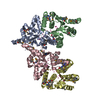
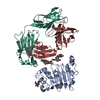
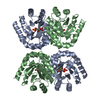
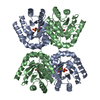

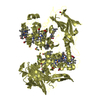


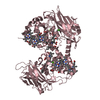
 PDBj
PDBj





















